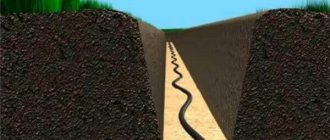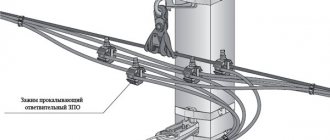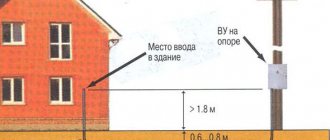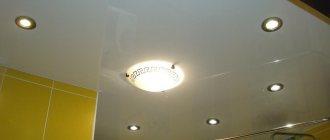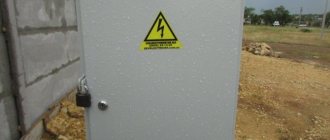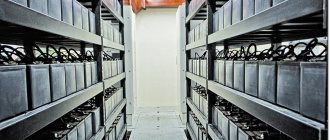The task itself looks somewhat strange. Why run wiring along the facade? First, let's understand the terms. If you go into the details of GOST: “a wire is a wire with or without a sheath...”, and “a cable is several wires...” and so on, you can get completely confused. Moreover, installing the wire along the wall of the building is impractical in principle. It must be inside. And if this is a power input, laying the cable along the facade of the building is generally prohibited; immediately after the suspension point it must be brought into the room.
All this is true, but we will talk about a relatively new cable (or wire, as defined by GOST) - SIP.
Self-supporting Insulated Wire (after all, a wire!) has recently been actively replacing non-insulated power wires. Residents of private houses know very well what it is. So, SIPs are allowed to be laid on the facades of buildings, and the norm is prescribed in the Rules for the Construction of Electrical Installations. When organizing the connection of households, this can bring significant savings for the owner.
In what cases is it necessary to lay a power cable along the facade?
The most obvious option: if an obstacle in the form of a building appears in the path of an overhead power line. It can be bypassed by organizing a route loop in the power line. But it will cost extra design money, and extra wire, not to mention poles. This is how they used to do it (when power lines were built only on bare wires). And since the Rules for the Construction of Electrical Installations (PUE) allow the laying of SIP along the facade (or any other walls), it is possible to draw a power line directly through the obstacle.
But this applies to energy drinks. We are interested in the applicability of the PUE permit for private houses, in the area of responsibility of the owner of the property.
- If the switchboard in the house is located on one side, and the main power line is on the other, it was necessary to install another pole (the length of the overhead line is limited in length). Often right on the site. A self-supporting insulated wire is laid through the air to the nearest point of the building, and to the switchboard it can go along the wall.
- The mounting point from the pole is too high on the wall, and the shield is located at the surface of the ground. It is necessary to organize the so-called cable lowering. The SIP is attached to the wall before entering the panel.
As an alternative, a transition is made from the aluminum conductors of the self-supporting wire to the copper conductors of the input power.
And then the usual cable is laid along the facade.
Information: why make transitions from aluminum SIP to conventional VVG?
It would seem easier to tighten the input wire directly into the shield without buying crimp sleeves or piercing couplings. But connecting the SIP to the metering device (meter) is so problematic that it is easier to make the transition and lay the VVG cable along the wall of the building.
How to organize bundles of wires
More and more equipment is appearing in our homes, and it all has wires. There are often about a dozen wires running to the desktop. To prevent them from getting confused, it is better to organize them. There are different types of plastic platforms for this. Some collect wires into bundles, while others, on the contrary, allow each thread to be routed separately.
Cable holder for organizing wires
Some of this cable fastening goes with self-tapping screws or nails, and some is based on Velcro. The second option can be safely installed on furniture. The adhesive adheres well to a laminated or varnished surface and there is no need to make holes.
What does the Electrical Installation Rules say about this?
- The cable being laid should not experience tension or pressure loads.
- At transition points (couplings, piercing connections, etc.) insulation must be provided, the properties of which correspond to the characteristics of the main wire.
- All outlets and connections must be accessible for inspection and repair without mechanical intervention in the building structure.
- All connections of wire and cable cores are made in accordance with the PUE: crimping, welding, soldering or crimping.
- In the case when the cable is laid along the facade using pipes, flexible hoses, closed boxes, the possibility of quickly replacing the wiring is provided.
- Structural elements, insulation, transition points must be selected based on the environment of use: weather conditions, exposure to ultraviolet rays, temperature conditions.
- Metal parts of the structure must be protected against corrosion.
- The length of the cable laid along the wall of the building is calculated taking into account the temperature gaps for compression and tension. The movement of the wire under the influence of temperature should not create conditions for mechanical tensile forces.
- In places of connection, branching, transitions, slack is provided (cable reserve in case of reconnection or repair).
Laying cables along the facade of a building without making a transition
General rules for external installation on the wall of a building:
Minimum distances to elements for horizontal installation:
- above the frames of windows or doors - 30 cm;
- under window frames or balcony platforms (lower plane) - 50 cm;
- above the ground - 275 cm.
Minimum distances to elements for vertical installation:
- to window frames - 50 cm;
- to the edge of balconies or doors - 100 cm.
The minimum distance from the SIP to the wall is 6 cm.
The last point requires decoding. It refers exclusively to SIP, and is associated with the features of its design. This wire does not have an outer layer of insulation; only the current-carrying conductors are coated. The insulating material (PET) supports combustion and retains its properties only at temperatures up to 70–90°, depending on the modification. In addition, there is a SIP with a bare core, which is used as a zero wire.
Due to its low fire resistance, this cable should not be attached close to the wall. If the cable catches fire, the fire will not spread to the wall. For installation, special façade fastenings are used.
Important! If, after laying the cable, insulating panels will be mounted on the wall, the distance to the self-supporting insulation insulation is calculated according to the new outer plane, increasing by the thickness of the panels.
SIP installation rules
With the growing number of energy consumers, SIP wires are effectively replacing conventional bare wires due to their practicality, reliability and safety. Self-supporting wire is widely used in the construction of new power lines, and SIP of four different modifications is also very popular in everyday life. Laying an electrical network using a self-supporting wire allows you to reduce the time it takes to put electrical networks into operation and provide electricity to residential and industrial facilities as quickly as possible. But to carry out installation work yourself, you need to know how to fasten SIPs. Methods for attaching SIP to a pole, types of fasteners, types of self-supporting cables, installation rules, recommendations from specialists when working with SIP will be discussed below.
We start dancing from the façade wall
First of all, you need to select a point on the wall from which the branch will begin. The rules for electrical installations do not regulate the choice of wall: it can be front or side. But in practice, in our latitudes it is the façade that is chosen. Roof slopes usually extend onto the side walls of buildings, from which ice (icicles) or snow can fall off.
The starting point for laying on the wall is considered to be the point where the cable exits the anchor clamp. The main design elements are shown in the illustration:
- Anchor bracket.
- An anchor clamp, after which the wire is not held on the overhead line route.
- Facade fastening is the first element of the wall installation system.
The bracket is installed at a height of at least 2.75 meters. The distance to the nearest corner of the load-bearing wall (excluding the thickness of the insulating material) is at least 10 cm.
Tip: If the cross-section of the power cable allows you to choose between different anchors, you should choose a hanger with a lower load. In this case, if there is a mechanical impact on the SIP (for example, caught by a truck on the road, or a pole falls), the wall will not be destroyed, the anchor will simply be torn off.
Description and types of SIP
A self-supporting electrical wire consists of several wires isolated from each other (aluminum wire intertwined). When laying new lines in accordance with GOST R 52373-2005, it is necessary to use a self-supporting cable. According to the new PUE rules, these cables are recommended to be used to connect electricity consumers.
Today there are the following types of SIP:
- SIP-1. This is a four-core cable used in three-phase electrical networks with voltages up to 1000 V. Moreover, three of its cores are designed for connecting phases (isolated from each other), and the fourth (zero) is without braid and has a steel core. They also produce SIP-1A cable, in which the neutral core is insulated.
- SIP-2. All cores in this cable are insulated. Its scope of application is the same as that of the cable described above.
- SIP-3. This is a single-core wire with polyethylene insulation. Thanks to the steel core, it is highly durable. It is used in electrical networks up to 35 kV.
- SIP-4. This is a four-core cable with polyethylene insulation, designed for power lines up to 1000 V. It does not have a steel core. It is often used to make branches from the main power line in country houses and in the private sector.
- SIP-5. It includes two or more insulated conductors, all of them without a steel core. This cable is used in electrical networks up to 1000 V.
Laying on the wall
Next, facade fasteners are used. If you purchase factory fittings, the distance is already regulated: at least 6 cm from the cable to the wall.
Then the cable route is marked and holes for fasteners are prepared. The distance between the fastening points is usually at least 70 cm. In bending areas, the frequency of fastening increases to prevent free sagging.
Important! If SIP is used, it is necessary to take into account the requirements for the geometry of the gasket. The bending radius is at least 10 cable diameters.
Then, using standard bolts, all facade fastenings are secured. To prevent corrosion and destruction of fasteners, the metal caps are closed with special plugs.
If house communications are located along the laying route, it is necessary to ensure a safe distance. At least 10 cm to water pipes, at least 40 cm to gas pipes.
Important! It is prohibited to form loose cable loops near metal structures.
Under wind load, the cable can fray the insulation and the wires will short out.
The use of fasteners that are intended for other purposes is not permitted. For example, pipe clamps or cable clips for indoor installation.
The importance of applying standards
To avoid danger when installing electrical wiring, you need to correctly calculate the cross-sectional area of the wires, because the resistance depends on it. The greater the resistance, the more the wires will heat up. An important role is played by the correct selection of cable materials, connection of wires, choice of installation location, and insulating materials. It is necessary to correctly calculate the load and select protective devices, do not forget about grounding.
An error can lead to a short circuit, and as a result, a fire occurs. To prevent this from happening, you need to use rules and regulations. If the building was erected without complying with them, the insurance company will not pay insurance in the event of an accident. Material losses can be quite significant, not counting human lives, the loss of which is irreparable.
This is interesting: Automatic before or after the RCD - how to do it correctly
An alternative to open cable routing along the façade
Reasons why you should not install SIP or other wires openly on the wall:
- The house is covered with fire-hazardous insulation, decorative upholstery: siding, wooden paneling.
- There is a danger of mechanical impact on the cable: opening shutters, tree branches, etc.
- Just for aesthetic reasons: I don’t want the cable to be laid along the facade at a distance of 6 cm from the wall.
- According to the characteristics, the cable used is not intended for open installation on external walls of buildings.
In this case, a closed cable duct or metal hose is used. It can be fixed directly to the wall. If the surface is covered with a flammable material, the hose should not support combustion.
There are no special requirements; the installation principle is similar to the SIP cable. The only mandatory condition is that when inserting the hose (box) into switching or distribution panels, protection is provided against moisture entering the internal cavity.
